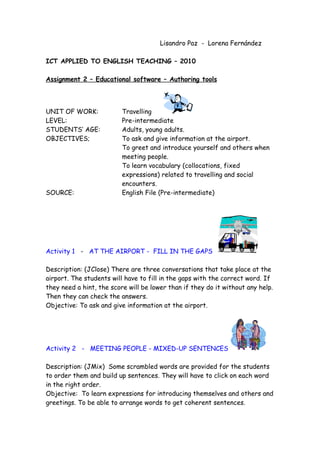
Hot potatoes lesson plan
- 1. Lisandro Paz - Lorena Fernández ICT APPLIED TO ENGLISH TEACHING – 2010 Assignment 2 – Educational software – Authoring tools UNIT OF WORK: Travelling LEVEL: Pre-intermediate STUDENTS’ AGE: Adults, young adults. OBJECTIVES; To ask and give information at the airport. To greet and introduce yourself and others when meeting people. To learn vocabulary (collocations, fixed expressions) related to travelling and social encounters. SOURCE: English File (Pre-intermediate) Activity 1 - AT THE AIRPORT - FILL IN THE GAPS Description: (JClose) There are three conversations that take place at the airport. The students will have to fill in the gaps with the correct word. If they need a hint, the score will be lower than if they do it without any help. Then they can check the answers. Objective: To ask and give information at the airport. Activity 2 - MEETING PEOPLE - MIXED-UP SENTENCES Description: (JMix) Some scrambled words are provided for the students to order them and build up sentences. They will have to click on each word in the right order. Objective: To learn expressions for introducing themselves and others and greetings. To be able to arrange words to get coherent sentences.
- 2. Activity 3 - CHECKING IN FOR A FLIGHT - CROSSWORD Description: (JCross) The students will have to click on the number of each word to read the definitions, then they will write the word in the gap provided for the answer and press ENTER, after this the word will be placed into the crossword automatically. Objective: To learn specific vocabulary related to the topic. This crossword will provide the students with the usual lexical items used when checking in for a flight. Activity 4 - TRAIN SERVICES - QUIZ Description: (JQuiz) The students will have to read a short text and answer the questions about it by filling in the gaps provided for the responses. Objective: To be able to understand a text and answer questions. Activity 5 - FREE TIME - MATCHING EXERCISE Description: (JMatch) The students will have to match the expressions to the corresponding picture by dragging it to the right place. Objective: To learn collocations with the verb GO. To talk about free time activities.
